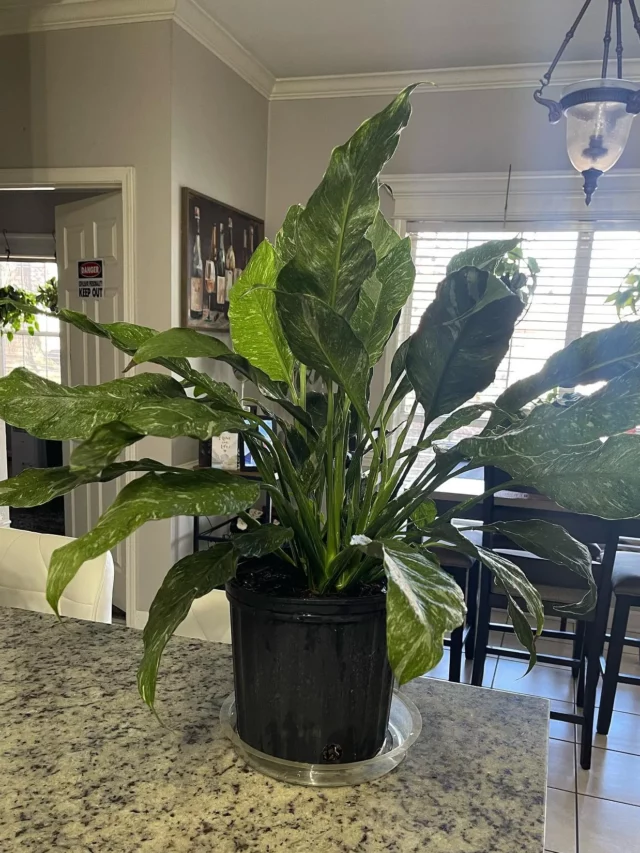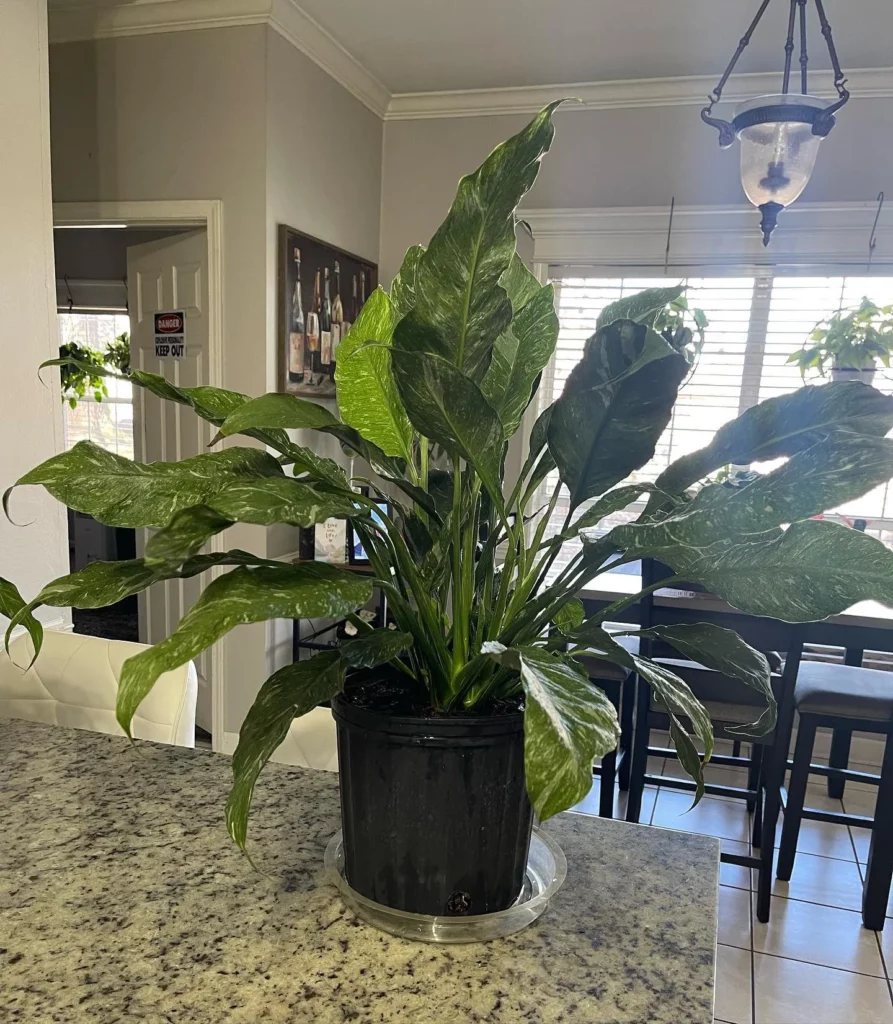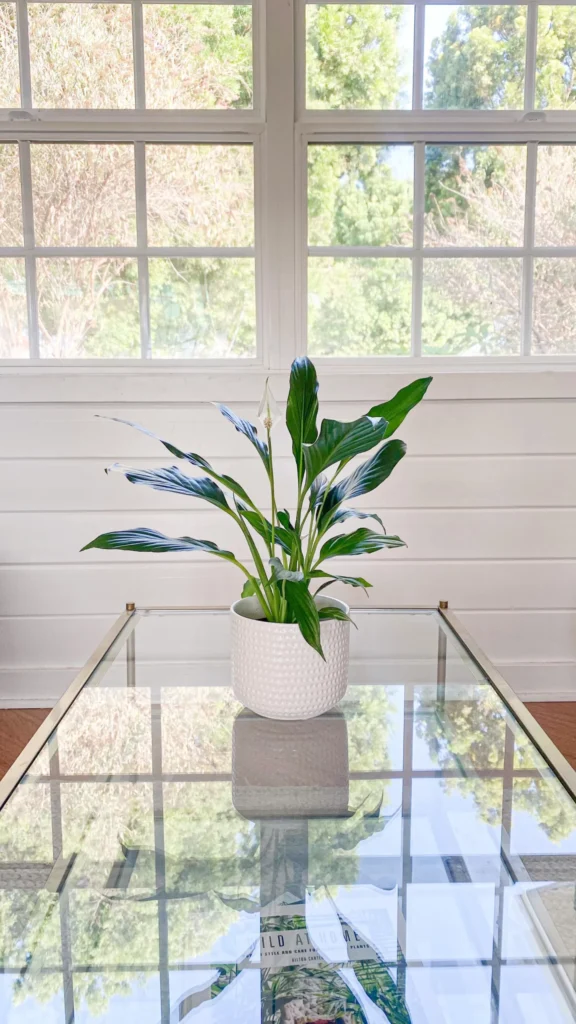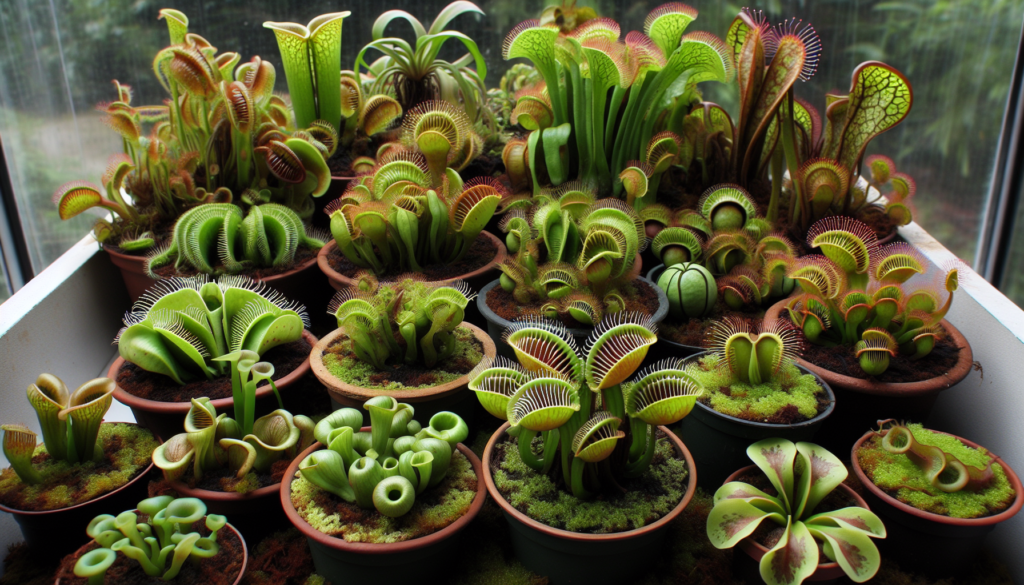Peace Lilies are known for their stunning appearance, making them a popular choice for indoor plant enthusiasts. With their glossy, dark green leaves and elegant white flowers called spathes, these plants add a touch of elegance to any indoor space.
From understanding their light requirements and proper watering techniques to fertilizing, potting, propagation, growth and development, and common pests and diseases, we’ve got you covered. Our goal is to equip you with the knowledge and confidence to care for your Peace Lily and create a healthy and beautiful indoor environment.
Appearance of Peace Lily
Peace Lilies can grow to be anywhere from one to four feet wide, and certain varieties can even reach up to six feet in height and width. Their lush foliage and beautiful blooms make them a visually appealing addition to your home or office.

Whether placed on a tabletop, shelf, or as a floor plant, the Peace Lily’s characteristics are sure to captivate and enhance the overall aesthetic of your interior decor.
Light Requirements for Peace Lily

eace Lilies are versatile plants that can thrive in a variety of lighting conditions. They can bring life and beauty to even the darkest corners of your home. Whether you have a brightly lit room or one that receives minimal light, a Peace Lily can be the perfect addition to your indoor space.
These plants are well-suited for low to bright, indirect sunlight. They can tolerate and even flourish in areas with lower light levels, making them ideal for rooms that don’t receive a lot of natural light. However, it’s important to avoid exposing your Peace Lily to direct sunlight for extended periods, as it can damage their leaves and cause their flowers to dry out.
When choosing a spot for your Peace Lily, consider placing it near a window where it can receive bright, filtered light. Avoid placing it directly in the path of intense, direct sunlight. If you notice the leaves turning yellow or brown, it may indicate that your Peace Lily is receiving too much light, and you should move it to a slightly shadier location.
Indoor Lighting Tips for Peace Lily:
- Choose a spot that allows your Peace Lily to receive bright, indirect sunlight.
- Avoid placing your Peace Lily in areas with intense, direct sunlight, as it can harm the plant.
- For rooms with low light, Peace Lilies can still thrive and bring beauty to your space.
- Observe your Peace Lily’s leaves to determine if it’s getting the right amount of light. Adjust its location accordingly.
Watering Peace Lily
One essential aspect of caring for your Peace Lily is providing it with the right amount of water. Proper watering ensures the plant’s overall health and vitality. Here’s what you need to know:
Weekly Watering
Peace Lilies generally thrive with weekly waterings. It’s important to keep the soil consistently moist but not overly saturated. When the top inch of the soil feels dry to the touch, it’s time to water your plant.
Indicators of Watering Needs
Peace Lilies have a unique way of letting you know when they need water. When the plant starts to droop its leaves, it’s a clear sign that it requires watering. The drooping can happen if the soil becomes too dry or if the plant is receiving excessive direct sunlight. Pay attention to this visual cue and respond promptly to prevent your Peace Lily from drying out.
Winter Watering
During the winter months, when the plant’s growth slows down, you can reduce the frequency of watering to every two weeks. Peace Lilies naturally go through a period of dormancy during this time, requiring less water to thrive. However, it’s crucial to regularly check the moisture level of the soil and adjust your watering schedule accordingly.
Avoid Overwatering
While Peace Lilies require adequate moisture, it’s important to avoid overwatering. Overly wet soil can lead to root rot, which can be detrimental to the health of your plant. To prevent overwatering, ensure that the pot has proper drainage holes and allow any excess water to drain away. Remember, it’s best to keep the soil slightly moist but not soggy.
Fertilizing Peace Lily

Instagram @thildesecher
Peace Lilies are beautiful and vibrant indoor plants that can bring life to any space. To ensure their health and promote growth, it’s important to fertilize them regularly during the growing season, typically from spring to summer.
When it comes to fertilizing your Peace Lily, using a general houseplant fertilizer is a simple and effective option. It’s recommended to feed your plant every two months to provide it with the necessary nutrients for optimal growth. This routine helps maintain a healthy, vigorous plant.
When fertilizing, it’s crucial to follow the manufacturer’s instructions and dilute the fertilizer before application. Applying an excessive amount of fertilizer can lead to root burn and damage the plant. Diluting the fertilizer ensures the proper amount is delivered to the roots without causing harm.
Peace Lilies have delicate roots, so it’s crucial to avoid overfeeding them. Follow the recommended dosage according to the fertilizer package or use a slightly lower concentration of fertilizer to be safe. This will help prevent any potential damage to the plant.
Fertilizing your Peace Lily can promote strong, lush foliage growth and encourage vibrant blooms. Peace Lilies are known for their striking white flowers, and proper fertilization can contribute to their beauty and longevity.
Potting Peace Lily
Peace Lilies prefer to be slightly root-bound, so they don’t require frequent repotting. You may only need to repot your plant every few years or when you see roots poking out from the bottom of the pot.
When repotting, choose a pot that is about 2 inches larger in diameter than the current one. This will provide enough space for the roots to grow and prevent the plant from becoming too crowded.
It’s important to ensure that the new pot has proper drainage to avoid waterlogged soil. This can lead to root rot and other issues. You can use pots with drainage holes or add a layer of rocks or pebbles at the bottom of the pot to enhance drainage.
When potting your Peace Lily, use well-draining potting soil to support healthy growth. This type of soil allows water to drain properly and prevents the roots from sitting in excess moisture.
Propagation of Peace Lily
Propagating Peace Lily is a great way to expand your collection or share the beauty of these plants with others. The propagation process involves division, which is a simple and effective method.
- Start by carefully separating the Peace Lily plant into smaller sections. Make sure that each section has roots attached to ensure successful propagation.
- Prepare separate pots with well-draining soil for each division. It’s important to use a good quality potting mix to provide the necessary nutrients and optimal growing conditions.
- Gently plant each division in its own pot, ensuring that the roots are properly covered with soil. Press the soil lightly to secure the plant in place.
- After planting, water the divisions thoroughly but avoid overwatering. Maintaining slightly moist soil is ideal for the initial growth phase.
- Place the newly potted divisions in a location with indirect sunlight. Peace Lilies prefer bright, indirect light, but avoid exposing them to direct sunlight, as it can cause damage to the leaves.
- In terms of care, treat the propagated divisions the same way you would care for mature Peace Lilies. This includes providing regular watering, maintaining proper humidity levels, and fertilizing during the growing season.
Growth and Development of Peace Lily
Peace Lilies have a moderate growth rate and can reach their full size within a few years. The growth of a Peace Lily is influenced by several factors, including the amount of light it receives, its water requirements, and the fertilization it receives.
With proper care and attention, a mature Peace Lily can grow to be one to four feet wide, making it an impressive addition to any indoor space. As the plant grows, it will produce more leaves and flowers, further enhancing its overall beauty.
Ensuring that your Peace Lily is placed in optimal lighting conditions, providing it with the right amount of water, and fertilizing it regularly will help promote healthy growth and development. Paying attention to these factors will ultimately determine the size and appearance of your Peace Lily.
Pests and Diseases of Peace Lily
While caring for your Peace Lily, you may encounter a few common pests and diseases that can affect its overall health and appearance. It’s important to be aware of these potential issues and take proactive measures to keep your plant thriving.
One of the most common pests that can infest Peace Lilies are spider mites. These tiny insects can create fine webs on the leaves and cause discoloration and stunted growth. Mealybugs and aphids are also common pests that can feed on the plant sap, leading to weakened foliage. Regularly inspect your Peace Lily for these pests, especially on the undersides of the leaves, and use appropriate methods to control their population.
Another problem that can arise with Peace Lilies is root rot caused by overwatering. When the roots are consistently waterlogged, they can become susceptible to fungal diseases, which can ultimately lead to the plant’s decline. To prevent root rot, make sure to water your Peace Lily sparingly and only when the top inch of soil has dried out. Ensure that the pot has adequate drainage to allow excess water to escape.
FAQ
What is a Peace Lily?
Peace Lily (Spathiphyllum) is a popular indoor plant known for its stunning appearance and air-purifying qualities. It has glossy, dark green leaves and elegant white flowers called spathes.
How big do Peace Lilies grow?
Peace Lilies can grow to be one to four feet wide, although some varieties can reach up to six feet tall and wide.
What are the light requirements for Peace Lily?
Peace Lilies can thrive in a wide range of light conditions, from low to bright, indirect sunlight. They are well-suited for bringing life to darker rooms or corners in your home.
How often should I water my Peace Lily?
Peace Lilies enjoy weekly waterings. When the plant starts to droop its leaves, it’s a clear sign that it requires watering. During the winter months, you can reduce the frequency of watering to every two weeks.
How often should I fertilize my Peace Lily?
Peace Lilies benefit from regular fertilizing during the growing season. Using a general houseplant fertilizer, feed your Peace Lily every two months.
When should I repot my Peace Lily?
Peace Lilies prefer to be slightly root-bound, so they don’t require frequent repotting. You may only need to repot your plant every few years or when you see roots poking out from the bottom of the pot.
How can I propagate my Peace Lily?
Peace Lilies can be propagated through division. Carefully separate the plant into smaller sections, ensuring that each section has roots attached. Plant the divisions in separate pots with well-draining soil and provide them with the same care as mature Peace Lilies.
How fast do Peace Lilies grow?
Peace Lilies have a moderate growth rate and can reach their full size within a few years. The growth depends on factors such as light, water, and fertilization.
What are the common pests and diseases that can affect Peace Lilies?
Common pests that can infest Peace Lilies include spider mites, mealybugs, and aphids. Overwatering can lead to root rot and fungal diseases. Regularly inspect your plant for any signs of pests or diseases and take appropriate measures to treat and prevent infestations.










